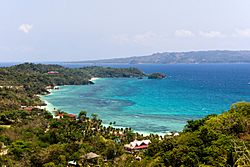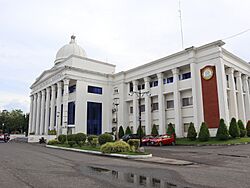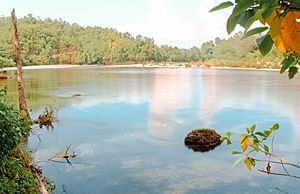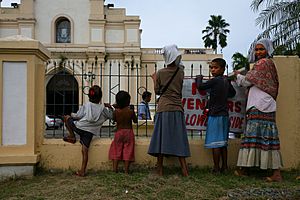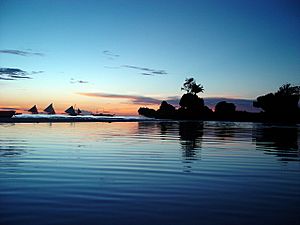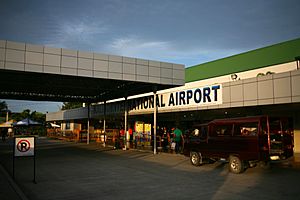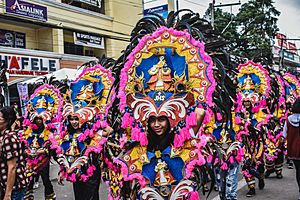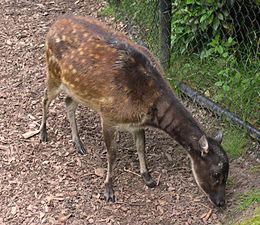Aklan facts for kids
Quick facts for kids
Aklan
|
|||
|---|---|---|---|
|
(from top: left to right) Boracay Island, Kalibo Cathedral, Ati-atihan Festival, Aklan Museum, Kalibo Bakhawan Eco Park, and Aklan Provincial Capitol.
|
|||
|
|||
| Nickname(s):
Oldest Province in the Philippines
|
|||
| Motto(s):
"Arangkada, Aklan"
|
|||
| Anthem: "Aklan Hymn" | |||
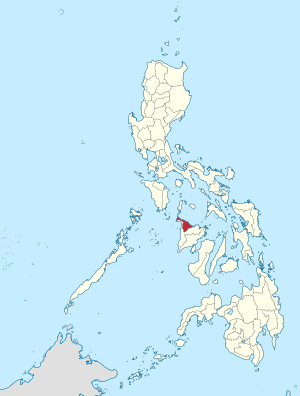
Location in the Philippines
|
|||
|
OpenStreetMap
|
|||
| Country | Philippines | ||
| Region | Western Visayas | ||
| First settled | 13th century | ||
| Founded | 25 April 1956 | ||
| Capital and largest municipality |
Kalibo | ||
| Area | |||
| • Total | 1,821.42 km2 (703.25 sq mi) | ||
| Area rank | 64th out of 81 | ||
| Highest elevation
(Mount Timbaban)
|
1,777 m (5,830 ft) | ||
| Population
(2020 census)
|
|||
| • Total | 615,475 | ||
| • Rank | 51st out of 81 | ||
| • Density | 337.9094/km2 (875.1814/sq mi) | ||
| • Density rank | 23rd out of 81 | ||
| Demonym(s) | Aklanon | ||
| Divisions | |||
| • Independent cities | 0 | ||
| • Component cities | 0 | ||
| • Municipalities |
17
Altavas
Balete Banga Batan Buruanga Ibajay Kalibo Lezo Libacao Madalag Makato Malay Malinao Nabas New Washington Numancia Tangalan |
||
| • Barangays | 327 | ||
| • Districts | Legislative districts of Aklan | ||
| Time zone | UTC+8 (PHT) | ||
| ZIP Code |
5600–5616
|
||
| IDD : area code | +63 (0)36 | ||
| ISO 3166 code | PH-AKL | ||
| HDI | |||
| HDI rank | 29th in Philippines (2019) | ||
| Spoken languages | |||
| GDP (2022) | ₱63.57 billion $1.084 billion |
||
| Growth rate | |||
| Website | aklan |
||
Aklan is a province in the Western Visayas region of the Philippines. Its capital and largest town is Kalibo. The province is located in the northwest part of Panay Island. It shares borders with Antique to the southwest and Capiz to the southeast. To the north, Aklan faces the Sibuyan Sea and Romblon province.
Aklan is famous for Boracay, a beautiful resort island just north of Panay. Boracay is known for its amazing white sand beaches and is a top travel spot in the Philippines. The Ati-Atihan Festival in Kalibo is also known worldwide. It's even called "The Mother of all Philippine Festivals." This festival happens every year on the third Sunday of January to honor the Santo Niño (Infant Jesus). During the festival, people dance in tribal costumes to ethnic music in the streets.
Contents
History of Aklan
Early Beginnings
People believe that Aklan was first settled in the 13th century. Settlers from Borneo, led by Datu Bangkaya, made their home here. His main village was Madyanos, close to what is now Numancia.
Spanish Rule
After Datu Manduyog, other leaders called datus ruled the area. Then, in 1565, Spanish explorer Miguel López de Legazpi arrived in Batan. He claimed the island for Spain. In early Spanish records, the area was called El Río de Aclán.
World War II and Freedom
In 1942, the Japanese took over Aklan during World War II. Later, in 1945, Filipino and American soldiers, along with local Aklanon fighters, freed Aklan during the war.
Becoming an Independent Province
Aklan became its own province on April 25, 1956. This happened when Philippine President Ramon Magsaysay signed Republic Act No. 1414. Before this, Aklan was part of Capiz. The province officially started on November 8, 1956. Jose Raz Menez was the first governor of Aklan.
Geography of Aklan
Aklan covers the northern part of Panay island. It is next to Capiz on the southeast and Antique on the southwest. To the north, it faces the Sibuyan Sea. The province is about 1,821.42 square kilometers in size. It also includes the famous island of Boracay at its northwestern tip.
The highest point in Aklan is Mount Timbaban. It stands at about 1,777 meters (5,830 feet) above sea level. The Aklan River is the longest river in the province, stretching 91 kilometers.
Aklan has many different landscapes. You can find white sandy beaches, mangrove forests, and mountains. The river Akean in the province is special because its water sometimes looks like it's "boiling or frothing."
Towns and Divisions
Aklan has 17 municipalities or towns. These towns are grouped into two legislative districts for government representation.
People of Aklan
Population and Density
In 2020, Aklan had a population of 615,475 people. This means there were about 338 people living in every square kilometer.
Ethnic Groups
Most people in Aklan are Aklanon. They are part of the larger Visayan ethnic group. There are also Negrito people, known as the Ati, and the Sulod, a tribal group living in the mountains of Panay. Other Visayan groups like the Hiligaynon, Karay-a, and Capiznon also live here.
Languages Spoken
The main languages in Aklan are Akeanon (Aklanon Proper), Malaynon, and Buruanganon. Akeanon is spoken by most people. Malaynon is spoken in Malay, and Buruanganon is spoken in Buruanga. Hiligaynon is also widely understood. Other local languages include Ati, Kinaray-a, and Capiznon. For official and business use, Tagalog and English are used.
Religion
Most people in Aklan are Roman Catholic. Christian holidays like Christmas and Lent are very important. Christian symbols, such as the Santo Niño, are also cultural symbols. Some Ati people still practice Animism, which involves believing in spirits. The Aglipayan Church is another important religion in the province. Other religions include Members Church of God International (MCGI), Iglesia ni Cristo, and Islam.
Economy of Aklan
Aklan is considered a first-class province, meaning it has a strong economy.
Farming
Farming is very important in Aklan. Palay (rice) is the main crop grown. Rice farms cover about 42,218 hectares.
Aklan usually produces enough meat, livestock, and poultry. However, the number of hogs and chickens decreased in 2000. This was due to high costs for feed and other supplies, animal diseases, and high labor costs.
Coconuts are also a major crop, covering 32,276 hectares. Makato is the top producer of copra (dried coconut meat). Other crops grown include bananas, mangoes, rambutan, and lanzones. Fiber crops like piña fiber and abaca are also important.
Fishing and Aquaculture
Fishpond areas cover about 7,807 hectares. These areas are used for raising fish and other seafood.
Local Products
Aklan is a top producer of abaca, a strong fiber. This fiber is dyed and made into clothes, placemats, bags, wall decorations, and fans.
The piña cloth, known as the "Queen of the Philippine Fabrics," is a special product from Kalibo. It is woven by hand on unique wooden or bamboo looms.
Lezo is famous for its red clay. Local people use this clay to make pots, vases, and other decorative items.
Transportation in Aklan
Roads
You can reach Aklan by highways and buses. Buses from Iloilo, Capiz, and Antique connect Aklan to nearby provinces. There's a plan for a new expressway called the Iloilo–Capiz–Aklan Expressway (ICAEx). It would run from Iloilo City to Caticlan, Malay. Also, a bridge connecting Caticlan to Boracay is being planned.
Airports
Because Boracay is so popular, Aklan has two busy airports: Kalibo and Caticlan. Both airports have direct flights to and from international cities like Taipei, Hong Kong, Beijing, Shanghai, Chengdu, Incheon, and Busan. Many airlines fly to these airports.
The airports in Aklan are:
- Kalibo International Airport
- Godofredo P. Ramos Airport (also known as Caticlan Airport)
Seaports
Aklan has several seaports:
- Alegria Port
- Batan Port
- Cagban Port
- Caticlan Jetty Port
- Tabon Port
- Tambisaan Port
- Gibon Port
- Colong-Colong Port
- Dumaguit Port
- Kalibo Jetty Port
- New Washington Port
Culture of Aklan
Even though Christianity is common, some old beliefs about the aswang (evil spirits) and babaylan (traditional healers) are still present. Kulam or witchcraft, called amulit by locals, is also feared by many.
Local Dishes
Two main dishes from Aklan are inubaran and binakol.
- Inubaran is a Filipino chicken stew or soup. It's made with chicken, diced banana pith (called ubad), coconut milk, a souring agent, lemongrass, and spices. The sour taste often comes from batuan fruits or libas leaves.
- Binakol is another Filipino chicken soup. It uses chicken cooked in coconut water with grated coconut, green papaya, leafy vegetables, and spices. Traditionally, it was cooked inside bamboo tubes or coconut shells.
- Linapay (also known as tinamuk) is similar to the dish Laing. It's made from pounded freshwater shrimp mixed with grated young coconut meat. This mixture is wrapped in taro leaves and cooked in coconut milk.
Festivals
Aklan is famous for its lively festivals, especially the Ati-Atihan festival in Kalibo.
- Ati-Atihan Festival is a celebration that started to honor a peace treaty between the Ati and Malay tribes. The Ati lived in the mountains, and the Malay people lived in the lowlands. During the dry season, the Ati would come down to trade and celebrate with the Malay tribes. When the Spanish arrived, they linked this festival to the Feast of the Santo Niño (Holy Child), which is held in January.
- Bariw Festival is a special festival in Nabas. It shows off the skills of people in Nabas in weaving bags, mats, and hats from bariw leaves. This festival is celebrated every May 14.
- Bugna Festival highlights local products and eco-tourism spots in Tangalan. These include a marine sanctuary, coral garden, and waterfalls. It takes place every May 16.
- Kali-Ugyon Festival in Libacao is celebrated from December 30 to January 1. The name means "happiness" and "unity." People wear modern and traditional costumes and celebrate in the streets to welcome the New Year.
Literature
Aklanons are known for their literature, including the epic story of Kalantiao. Writers like Melchor F. Cichon and Roman Aguirre have created important literary works in the province.
Ati-Atihan Festival
The Ati-Atihan Festival is a big celebration held every year in honor of the Santo Niño (Infant Jesus). It takes place on the third Sunday of January in Kalibo, Aklan, on Panay Island. This festival actually started in Batan, Aklan and was later adopted by other nearby towns. The name Ati-Atihan means "to be like Atis" or "to pretend to be Atis." The Atis are the native people who first lived on Panay Island.
The festival includes tribal dances, music, and parades with people wearing traditional costumes and carrying weapons. Both Christians and non-Christians celebrate this day with religious processions. The Ati-Atihan Festival has inspired many other Philippine festivals, like the Sinulog Festival in Cebu and Dinagyang in Iloilo City. It is officially known as "The Mother of All Philippine Festivals" because it is the oldest festival in the Philippines.
The costumes worn at the festival are similar to African tribal designs, like those seen at the Rio Carnival in Rio de Janeiro, Brazil.
The festival's origins date back to around 1200 A.D. A group of 10 Malay chieftains, called Datus, came to the Philippines from Borneo. The Ati people, who were the original tribes of Panay Island, allowed them to settle. Datu Puti traded with the Ati, buying the plains for a golden hat, brass basins, and cloth. They also gave a long necklace to the Ati chieftain's wife. After this trade, there were many feasts and celebrations.
Later, the Ati people faced a bad harvest and a famine. They had to come down from their mountain village to ask for help from the people living in the lowlands. The Datus helped them by giving them food. In return, the Ati danced and sang to show their thanks.
The festival was originally a pagan celebration by the Ati tribe, who practiced Animism and worshipped their anito gods. Spanish missionaries later added a Christian meaning to it. Today, the Ati-Atihan is celebrated as a religious festival.
In 2012, the National Commission for Culture and the Arts (NCCA) and UNESCO recognized the Ati-atihan Festival as an important part of Philippine cultural heritage. The local government of Aklan can even nominate the festival for the UNESCO Intangible Cultural Heritage Lists.
During the festival, people attend church services for the Santo Niño and go to dances. The festival officially begins with a special church mass. Then, a procession starts with rhythmic drumbeats and dances in the streets. The second day begins early in the morning with a rosary procession, followed by a community mass and another procession. People often shout "Hala Bira! Pwera Pasma!" during the festival. This phrase is linked to the Sto. Nino Ati-Atihan Festival because people keep celebrating all over town, day and night, for a week or more, no matter the weather. They believe that the miraculous Child Jesus will protect them from harm and sickness. The main event of the festival is on the third Saturday of January, when different tribal groups compete. The festival ends on the third Sunday with a procession of thousands of people carrying torches and different images of the Santo Niño. The winners of the competitions are announced at a masquerade ball, which officially closes the festival.
Universities and Colleges
Aklan is home to the Regional Science High School for Region VI (RSHS-VI), a special public high school in the Philippines.
Here are some of the universities and colleges in Aklan:
- Aklan Catholic College
- Aklan Polytechnic College
- Aklan State University (with campuses in Banga, Ibajay, Kalibo, Makato, and New Washington)
- Altavas Colleges
- Balete Community College
- Batan Community College
- Canadian Tourism & Hospitality Institute — Boracay
- Carillo Culinary Arts and Skills Development Center
- Central Panay College of Science and Technology
- FEATI University — Kalibo
- Garcia College of Technology
- Madyaas Institute
- Numancia Integrated School (NIS)
- JAVTES College — Kalibo
- Lezo Technical College
- Montfort Technical Institute
- New OFW Vocational and Technical School
- Northwestern Visayan Colleges
- Numancia National School of Fisheries
- Panay Technological College
- Provincial Academic Center College of Nursing
- Saint Gabriel College
- Saint Anne Business School
- STI College of Kalibo
- Santo Niño Seminary
- Verde Grande Culinary School
- Western Pacific College
- Infant Jesus Academy Kalibo
- Infant Jesus School
Animals and Plants
Many animal and plant species found only in the Philippines live in Aklan. These include endangered animals like the Philippine spotted deer (Cervus alfredi), the Visayan warty pig (Sus cebifrons), and the Visayan hornbill (Penelopides panini). Efforts are being made by the Aklan State University and the DENR to protect these species. Three types of mangrove trees that are on the World's Red List (meaning they are vulnerable or endangered) are found in the forests of Ibajay, Aklan.
Notable People from Aklan
- Jonha Richman – businesswoman and philanthropist
- Gabrielle Calizo-Quimpo – politician
- Col. Alejandro Melchor Sr. (1900-1947) — designed the pontoon bridge used in World War II; served as Secretary of National Defense and military adviser to President Sergio Osmeña
- Jaime Cardinal Sin – Catholic Archbishop of Manila
See also
 In Spanish: Aclán para niños
In Spanish: Aclán para niños


